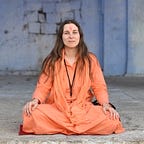Atman
In many ways, the goal determines the outcome and effectiveness of the practice. Unfortunately, in our time, yoga ceases to be yoga, because the goals it should be directed to are lost along the way and techniques without the goal are quite useless. With the information available to everyone, anyone can take any technique and somehow apply it or make a business out of it. And such businesses in order to be competitive create more new techniques that like goods and services are sold to people. And people tend to change yoga schools and teachers to find the best and newest techniques. With the proper goal same asanas that people do in all these yoga centers as a form of gymnastics or as a means to losing weight, could help gaining a completely different result of energy transformation and spiritual development. Therefore, the landmarks define the practice, fill it. Technique itself without the right goals and focus is imperfect.
In India, in the culture where yoga arose, there is such a combination of three concepts: sadhaka — one who does something, sadhana — a process of practice, and sadhya — the goal. These three are always go together. They are inseparable. It is similar to the triad object of discovery, discoverer and the process of discovery. That is, they are connected. If one thing is missing, then everything falls apart. Therefore, practice is always connected to the goals of practice.
What should the practice of traditional yoga lead to? This is primarily self-discovery. Discovery of what is called Atman in the texts. This is not the only goal of yoga, but it is primary one. Without understanding who you really are, it is very difficult to move on. It is like a step or milestone on the yogic path. Because there is such a goal as liberation (moksha). This is a very high and tempting goal for yogis. Moksha is not so easily attainable, because it involves liberation from all influences. And without understanding your inner nature, it is very difficult to move towards it. That is, the movements will be almost blind. Of course, if there is a Teacher, he leads the disciple, but still leads to the disciple’s true nature. And further with this understanding, much easier to move forward, there is more clarity about what is the practitioner doing, what happens in practice. Because one can practice for 20 or 30 years and be disappointed that nothing leads anywhere, nothing changes, only bones hurt to perform asanas. It is so important to keep the right focus all these years of practice, not moving aside as Maya and society incline us, remember why we practice and learn our own nature, our core — Atman.
Every person has Atman; it is inherent in us. We can’t leave Atman and go somewhere. Atman is always with us. It is not even a question of knowledge as such, because Atman can’t be known the way we learn about other things, the way how we explore something in this world, study it. Because Atman is beyond knowledge. Atman is knowledge itself, the very essence. It is easy to fall into the trap of words, because words are limited and pull associations. And it is very difficult to describe such concepts, such realities in ordinary words, and it is always easy to logically refute any judgments.
True nature is our natural state, everything else is not ours, it is temporary. This body was given to us by God or nature, by parents, but our “I”, our Atman, is exactly what is ours. Nothing more of ours is here and cannot be. And when a person accidentally touches this state, at least for a short while, for a moment, minute, second, it doesn’t matter how long, because he enters into eternity, and there is no time and no matter how much you are in stayed there, because there is no time. From the side you can say that 5 minutes have passed, but you yourself cannot say how much time has passed, it was infinitely small and infinitely long moment of time. Then you can get carried away with something external, but this brief moment can become the core for further practice. This is not what you just read or someone told you, but you yourself comprehended it, felt that you are eternal, you cannot die while this Universe exists. Even when this world collapses to a point, you will also be there.
Ancient texts, Upanishads, explain that there are Atman and Brahman, and they are identical, that Brahman is the whole Absolute — the Creator and his creation, and Atman is the same eternal Brahman, but in every living being. From the fact that Atman is enclosed in a body, Atman does not cease to be Brahman, does not lose his eternal divine nature.This is that yogic texts mentioned, Atman is Brahman, you are not separate from Universe, moreover, you are Universe itself and even beyond.
This is what is called truth, which is very, very difficult to talk about, because words always diminish significance. For a person who has experienced this and is trying to talk about it, his subtle experience begins to become more gross, it becomes completely different from what he felt. These enlightening moments can change a person’s whole life, his attitude to everything. And therefore, each person should practice this direction at least a little bit, because knowing your true nature is really needed in life. Many mental disorders, misunderstanding of many things — begin to disappear. This is why yoga exists for so long and has not been forgotten, has not been lost for so many millennia.
